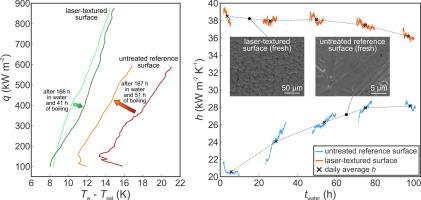Applied Thermal Engineering ( IF 6.1 ) Pub Date : 2020-09-11 , DOI: 10.1016/j.applthermaleng.2020.116025 Matic Može

|
Despite its importance for practical applications, investigation of aging of enhanced boiling heat transfer surfaces, which occurs during exposure to the boiling process, is often neglected. This study explores the boiling-induced aging behavior of an untreated and a laser-textured copper boiling surface during an eight-day testing period under pool boiling conditions using saturated water at atmospheric pressure. During the test, approx. 40-50 h of intermittent boiling operation were simulated. Boiling curve measurements are used to quantify boiling performance and measurements during steady state operation periods are used to analyze the heat transfer coefficient variations. SEM imaging, contact angle measurements and Raman spectroscopy are used to analyze the surface morphology, chemistry and wettability before and after exposure to hot water and boiling. The results show that no universal prediction of aging effects is possible. A distinct two-stage aging behavior resulting in increased performance was observed on the reference surface, while the boiling performance of the laser-textured surface changed very little during the test. The results also indicate that functionalized surfaces, which might primarily rely on surface microtopography for boiling enhancement, are presumably less prone to boiling behavior changes resulting from oxidation since slight changes in surface wettability will only have a minor effect on the overall boiling performance. Furthermore, evaluation of long-term performance of enhanced surfaces is necessary since their aging behavior differs from untreated surfaces.
中文翻译:

沸腾老化对未处理和激光织构铜表面的池沸腾传热性能的影响
尽管其对于实际应用很重要,但通常忽略了在暴露于沸腾过程中发生的增强沸腾传热表面的老化研究。这项研究探索了未经处理的表面和激光纹理化的铜沸腾表面在池沸腾条件下使用大气压下的饱和水在八天的测试时间内的沸腾诱导的老化行为。在测试期间,大约 模拟了40-50小时的间歇沸腾操作。沸腾曲线测量用于量化沸腾性能,稳态运行期间的测量用于分析传热系数变化。SEM成像,接触角测量和拉曼光谱用于分析表面形态,暴露于热水和沸腾前后的化学性质和润湿性。结果表明,不可能普遍预测老化效果。在参考表面上观察到明显的两阶段老化行为,导致性能提高,而激光纹理化表面的沸腾性能在测试过程中变化很小。结果还表明,可能主要依赖于表面微观形貌来提高沸腾作用的功能化表面,由于氧化性的轻微变化只会对整体沸腾性能产生较小的影响,因此较不容易发生由氧化引起的沸腾行为变化。此外,必须评估增强表面的长期性能,因为它们的老化行为与未经处理的表面不同。结果表明,不可能普遍预测老化效果。在参考表面上观察到明显的两阶段老化行为,导致性能提高,而激光纹理化表面的沸腾性能在测试过程中变化很小。结果还表明,可能主要依赖于表面微观形貌来提高沸腾作用的功能化表面,由于氧化性的轻微变化只会对整体沸腾性能产生较小的影响,因此较不容易发生由氧化引起的沸腾行为变化。此外,必须评估增强表面的长期性能,因为它们的老化行为与未经处理的表面不同。结果表明,不可能普遍预测老化效果。在参考表面上观察到明显的两阶段老化行为,导致性能提高,而激光纹理化表面的沸腾性能在测试过程中变化很小。结果还表明,可能主要依赖于表面微观形貌来提高沸腾作用的功能化表面,由于氧化性的轻微变化只会对整体沸腾性能产生较小的影响,因此较不容易发生由氧化引起的沸腾行为变化。此外,必须评估增强表面的长期性能,因为它们的老化行为与未经处理的表面不同。在参考表面上观察到明显的两阶段老化行为,导致性能提高,而激光纹理化表面的沸腾性能在测试过程中变化很小。结果还表明,可能主要依赖于表面微观形貌来提高沸腾作用的功能化表面,由于氧化性的轻微变化只会对整体沸腾性能产生较小的影响,因此较不容易发生由氧化引起的沸腾行为变化。此外,必须评估增强表面的长期性能,因为它们的老化行为与未经处理的表面不同。在参考表面上观察到明显的两阶段老化行为,导致性能提高,而激光纹理化表面的沸腾性能在测试过程中变化很小。结果还表明,功能化表面可能主要依赖于表面微观形貌来增强沸腾作用,因为表面润湿性的细微变化只会对整体沸腾性能产生较小影响,因此可能不易产生由氧化引起的沸腾行为变化。此外,必须评估增强表面的长期性能,因为它们的老化行为与未经处理的表面不同。结果还表明,功能化表面可能主要依赖于表面微观形貌来增强沸腾作用,因为表面润湿性的细微变化只会对整体沸腾性能产生较小影响,因此可能不易产生由氧化引起的沸腾行为变化。此外,必须评估增强表面的长期性能,因为它们的老化行为与未经处理的表面不同。结果还表明,可能主要依赖于表面微观形貌来提高沸腾作用的功能化表面,由于氧化性的轻微变化只会对整体沸腾性能产生较小的影响,因此较不容易发生由氧化引起的沸腾行为变化。此外,必须评估增强表面的长期性能,因为它们的老化行为与未经处理的表面不同。











































 京公网安备 11010802027423号
京公网安备 11010802027423号